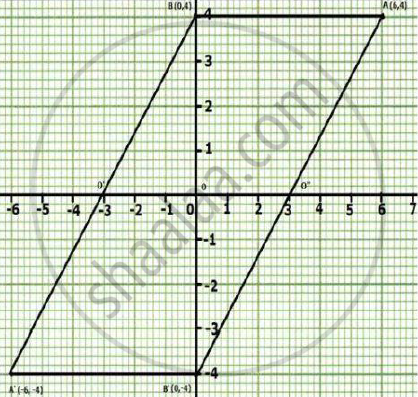Advertisements
Advertisements
प्रश्न
Using a graph paper, plot the point A (6, 4) and B (0, 4).
(a) Reflect A and B in the origin to get the image A’ and B’.
(b) Write the co-ordinates of A’ and B’.
(c) Sate the geometrical name for the figure ABA’B’.
(d) Find its perimeter.
उत्तर
(a)
(b) Co-ordinates of A'=(-6,-4)
Co-ordinates of B'=(0,-4)
(c) ABA'B' is parallelogram.
(d) In ABA'B',BB'=8 units, A'B'=6 units
`therefore BA'=sqrt(6^2+8^2)=sqrt(36+64)=sqrt100=10 `units
`=>B'A=10 ` units
AB=A'B'=6units
∴ the perimeter of ABA'B'=AB+BA'+A'B'+B'A
=6+10+6+10
=32 units
APPEARS IN
संबंधित प्रश्न
Attempt this question on graph paper.
- Plot A (3, 2) and B (5, 4) on graph paper. Take 2 cm = 1 unit on both the axes.
- Reflect A and B in the x-axis to A’ and B’ respectively. Plot these points also on the same graph paper.
- Write down:
- the geometrical name of the figure ABB’A’;
- the measure of angle ABB’;
- the image of A” of A, when A is reflected in the origin.
- the single transformation that maps A’ to A”.
- Point P (a, b) is reflected in the x-axis to P’ (5, –2). Write down the values of a and b.
- P” is the image of P when reflected in the y-axis. Write down the co-ordinates of P”.
- Name a single transformation that maps P’ to P”.
The point (–2, 0) on reflection in a line is mapped to (2, 0) and the point (5, –6) on reflection in the same line is mapped to (–5, –6).
- State the name of the mirror line and write its equation.
- State the co-ordinates of the image of (–8, –5) in the mirror line.
A point P (–2, 3) is reflected in line x = 2 to point P’. Find the co-ordinates of P’.
Points A and B have co-ordinates (3, 4) and (0, 2) respectively. Find the image:
- A’ of A under reflection in the x-axis.
- B’ of B under reflection in the line AA’.
- A” of A under reflection in the y-axis.
- B” of B under reflection in the line AA”.
The point P (5, 3) was reflected in the origin to get the image P’.
- Write down the co-ordinates of P’.
- If M is the foot of the perpendicular from P to the x-axis, find the co-ordinates of M.
- If N is the foot of the perpendicular from P’ to the x-axis, find the co-ordinates of N.
- Name the figure PMP’N.
- Find the area of the figure PMP’N.
The point P (3, 4) is reflected to P’ in the x-axis; and O’ is the image of O (the origin) when reflected in the line PP’. Write:
- the co-ordinates of P’ and O’.
- the length of the segments PP’ and OO’.
- the perimeter of the quadrilateral POP’O’.
- the geometrical name of the figure POP’O’.
A (1, 1), B (5, 1), C (4, 2) and D (2, 2) are vertices of a quadrilateral. Name the quadrilateral ABCD. A, B, C, and D are reflected in the origin on to A’, B’, C’ and D’ respectively. Locate A’, B’, C’ and D’ on the graph sheet and write their co-ordinates. Are D, A, A’ and D’ collinear?
The triangle ABC, where A is (2, 6), B is (–3, 5) and C is (4, 7), is reflected in the y-axis to triangle A'B'C'. Triangle A'B'C' is then reflected in the origin to triangle A"B"C".
- Write down the co-ordinates of A", B" and C".
- Write down a single transformation that maps triangle ABC onto triangle A"B"C".
Use graph paper for this question.
(Take 2 cm = 1 unit along both x-axis and y-axis.)
Plot the points O(0, 0), A(–4, 4), B(–3, 0) and C(0, –3).
- Reflect points A and B on the y-axis and name them A' and B' respectively. Write down their co-ordinates.
- Name the figure OABCB'A'.
- State the line of symmetry of this figure.
